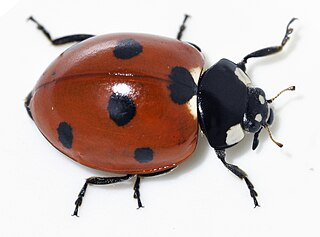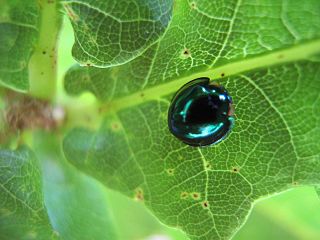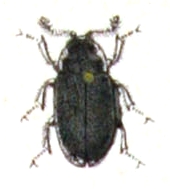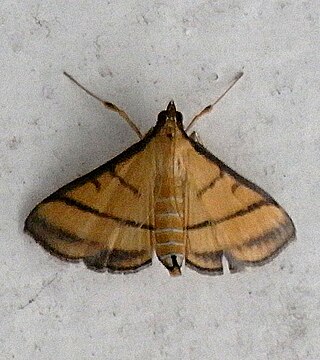
The huhu beetle is a longhorn beetle endemic to New Zealand. It is the heaviest beetle found in New Zealand.

Adalia bipunctata, the two-spot ladybird, two-spotted ladybug or two-spotted lady beetle, is a carnivorous beetle of the family Coccinellidae that is found throughout the holarctic region. It is very common in western and central Europe. It is also native to North America but it has heavily declined in many states and provinces. It is commonly introduced and imported as a biological control agent.

Eacles imperialis, the imperial moth, is a member of the family Saturniidae and subfamily Ceratocampinae. It is found mainly in the East of South America and North America, from the center of Argentina to south Canada. The species was first described by Dru Drury in 1773.

Actias selene, the Indian moon moth or Indian luna moth, is a species of saturniid moth from Asia. It was first described by Jacob Hübner in 1807. This species is popular among amateur entomologists and is often reared from eggs or cocoons that are available from commercial sources. They fly mainly at night.

Acherontia atropos, the African death's-head hawkmoth, is the most widely recognized of three species within the genus Acherontia. It is most commonly identified by the vaguely skull-shaped pattern adorning the thorax, the characteristic from which its common and scientific names are derived. The species was first given its scientific name by Carl Linnaeus in his 1758 10th edition of Systema Naturae.

Coccinellidae is a widespread family of small beetles. They are commonly known as ladybugs in North America and ladybirds in the United Kingdom; "lady" refers to mother Mary. Entomologists use the names ladybird beetles or lady beetles to avoid confusion with true bugs. The more than 6,000 described species have a global distribution and are found in a variety of habitats. They are oval beetles with a domed back and flat underside. Many of the species have conspicuous aposematic (warning) colours and patterns, such as red with black spots, that warn potential predators that they taste bad.

Papilio anactus, the dainty swallowtail, dingy swallowtail or small citrus butterfly is a medium-sized butterfly from the family Papilionidae, that is endemic to Australia.

Halmus chalybeus, commonly known as the steelblue ladybird, is a species of ladybird native to Australia. It has a rounded appearance with an iridescent blue/green colouration and is a predator of other insects. It was introduced to New Zealand from Australia in 1899 and 1905 to control black scale and blue gum scale on citrus trees, where it is now common in northern regions. It has also been recorded eating San Jose scale. They are about 3–4 mm long.

Coccinella leonina, common name orange-spotted ladybird, is a species of ladybird native to New Zealand. It is black with orange spots. A predator species, it is present in a variety of habitats.

Harmonia antipodum, known as the antipodean ladybird, is a species of ladybird beetle indigenous to New Zealand, though sometimes mistaken for a related non-native species, Harmonia conformis. They are a brown colour, and about 3 mm long, while H. conformis is much larger and more conspicuously coloured.

Dermestes frischii is a species of beetle found in the Palearctic, including Europe, tropical Africa, the Near East, the Nearctic, North Africa and East Asia. In Europe, it is known from Albania, Bosnia and Herzegovina, Bulgaria, Corsica, Croatia, the Czech Republic, mainland Denmark, European Turkey, Finland, mainland France, Germany, mainland Greece, Hungary, mainland Italy, Kaliningrad, Moldova, North Macedonia, mainland Norway (doubtful), Poland, Russia, Sardinia, Sicily, Slovakia, mainland Spain, Sweden, Ukraine and Yugoslavia.

Cnaphalocrocis medinalis, the rice leafroller, is a species of moth of the family Crambidae. It is found in south-east Asia, including Hong Kong, Sri Lanka, Taiwan, Thailand and most of Australia.

Dinocampus coccinellae is a braconid wasp parasite of coccinellid beetles, including the spotted lady beetle, Coleomegilla maculata. D. coccinellae has been described as turning its ladybird host into a temporary "zombie" guarding the wasp cocoon. About 25% of Coleomegilla maculata recover after the cocoon they are guarding matures, although the proportion of other ladybird species which recover is much lower.

Harmonia testudinaria, commonly known as the tortoise-shelled ladybird, is a species of ladybird belonging to the family Coccinellidae. The tortoise shelled-ladybird occurs in Australia, New Guinea, Indonesia and Hawaii.

Hendecasis duplifascialis, the jasmine budworm, is a moth in the family Crambidae.

Archichauliodes diversus is an insect in the subfamily Chauliodinae - the fishflies, though it is often referred to as the New Zealand dobsonfly, despite not being a true dobsonfly. In its larval form it is commonly known by the name toe-biter, and its Māori name is puene. The species is native to New Zealand. Although there are many other species of fishfly in other parts of the world, Archichauliodes diversus is the only species of fishfly in New Zealand.

Chironomus zealandicus, commonly known as the New Zealand midge, common midge, or non-biting midge, is an insect of the Chironomidae family that is endemic to New Zealand. The worm-like larvae are known to fisherman and have a common name of blood worm due to their red color and elongated blood gills.

Harmonia octomaculata is a species of ladybird of the family Coccinellidae. It is found throughout India, Pakistan, Nepal, Bangladesh, Sri Lanka, Micronesia, and Australia.
Afidenta misera, is a species of lady beetle widespread in the Oriental region.
Silana farinosa, commonly known as curry-leaf tortoise beetle, is a species of leaf beetle native to Indo-China, India, Sri Lanka, Thailand and introduced to Peninsular Malaysia.


















